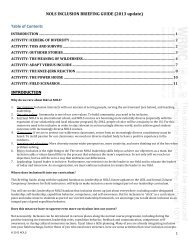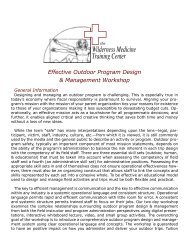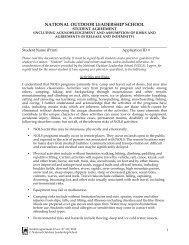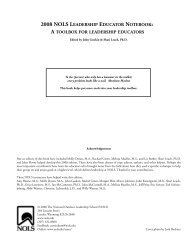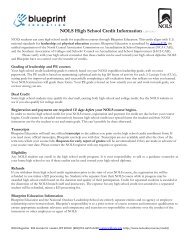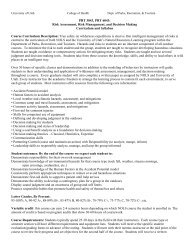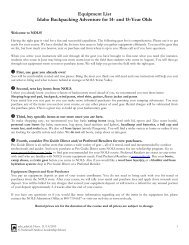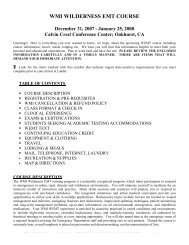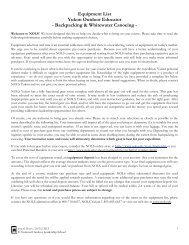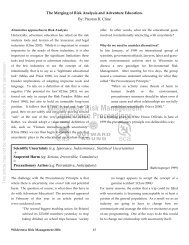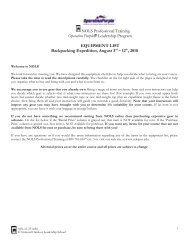Essential Eligibility Criteria (EEC) - NOLS
Essential Eligibility Criteria (EEC) - NOLS
Essential Eligibility Criteria (EEC) - NOLS
You also want an ePaper? Increase the reach of your titles
YUMPU automatically turns print PDFs into web optimized ePapers that Google loves.
<strong>NOLS</strong> Student <strong>Essential</strong> <strong>Eligibility</strong> <strong>Criteria</strong> Revisions October 2010 The <strong>NOLS</strong> <strong>Essential</strong> <strong>Eligibility</strong> <strong>Criteria</strong> (<strong>EEC</strong>) is applicable to all <strong>NOLS</strong> students. The mission of the National Outdoor Leadership School is to be the leading source and teacher of wilderness skills and leadership that serve people and the environment. <strong>NOLS</strong> courses are multi-‐week wilderness expeditions with the goal of training outdoor leaders. The wilderness environments <strong>NOLS</strong> courses live in and travel through, as well as the activities they undertake, are remote, dynamic, challenging and committing. The health and well being of our students and staff are a top priority, as is the effective education of our students. To achieve these goals for a group in a wilderness setting each student must be fully committed to and capable of working hard, taking responsibility for him or her self, and working effectively in the group. <strong>NOLS</strong> does not specialize in integrating people with disabilities onto courses. <strong>NOLS</strong> instructors are well-trained and experienced outdoor leaders and educators, but are not specifically trained to teach to or supervise people with disabilities and cannot be expected to be an advocate for a student with a disability. <strong>NOLS</strong> embraces diversity and strives to create a positive learning environment. The majority of <strong>NOLS</strong> students are not seeking an integrated experience. The <strong>Essential</strong> <strong>Eligibility</strong> <strong>Criteria</strong> are applicable for all students. A qualified person is one who can meet the <strong>EEC</strong> for participation in the program activity. If an applicant is unable to meet certain criteria, we might be able to assist him or her with reasonable accommodation unless it alters the fundamental nature of the course; compromises the health and safety of students or staff; or places an undue financial or administrative burden on <strong>NOLS</strong>. ESSENTIAL ELIGIBILITY CRITERIA FOR PARTICIPATION ON <strong>NOLS</strong> COURSES: Section one is the <strong>EEC</strong> for all <strong>NOLS</strong> courses. Section two is the <strong>EEC</strong> for specific types of courses or activities. 1.a. Safety and Judgment Each participant must… • Be able to effectively warn others of potential or impending dangers such as falling rocks, aggressive animals or other environmental hazards. • Be able to effectively signal or notify course instructors or other course members of personal distress, injury or need for assistance. • Be able to do the preceding warnings and notifications up to a distance of 50 meters and in conditions with limited visibility such as in darkness or inclement weather or with loud background noise, such as high winds or while near roaring rivers.
• Independently perceive, understand and follow directions and instructions given by others to be able to successfully execute appropriate and perhaps unfamiliar, techniques to avoid hazards and /or manage risks. These directions may be given before the hazard or risk is encountered or may need to be given during exposure to the hazard/risk. • Be able to stay alert and to focus attention for up to several hours at a time while traveling in wilderness terrain, attending classes or receiving instructions. • Be able to perceive and comprehend significant and apparent hazards, including ones previously identified by instructors. These hazards may include, but are not limited to, fast moving water (rivers, creeks, surf, tides), cliff edges, loose rock, crevasses, potentially hazardous animals and insects and rugged, steep and uneven terrain. • Act reliably around above stated hazards to minimize risk even when not directly supervised. • Be able to respond appropriately to stress or crisis such as when encountering large and/or potentially hazardous animals, severe weather, or a medical emergency. • If taking prescription medications, be able to maintain proper dosage by self-‐medicating without assistance from instructors or others (except possibly in emergency situations). 1.b. Leadership and Expedition Behavior Each participant must… • Work effectively as a member of a team despite potentially stressful and difficult conditions. This may require problem solving on an interpersonal or group level as well as a willingness to accept differences. • Contribute to a safe learning environment – no harassing or abusive behavior of others for any reason. • Be able to willingly and equally share responsibility with tent mates in daily tent group chores. Each student may not do an equal share each day, bit over a period of several days each student should do a proportionate share. All students are learning the skills and being challenged by the conditions and activities; there can be no expectation that any other student will be able to continually assume a greater share of the work or that an instructor can continually focus a greater share of his/her energy and time on one student. • Effectively communicate ideas and concerns on an individual and group level. • Have the cognitive ability to learn necessary skills given normal time limitations of a <strong>NOLS</strong> course. 1.c. Environmental Ethics Each participant must… • Learn and then practice Leave No Trace camping and travel techniques. Student <strong>Essential</strong> <strong>Eligibility</strong> <strong>Criteria</strong> - 2010 page 2
1.d Outdoor Skills: Camping Each participant must… • Learn and safely perform the fundamental camping skills of finding a campsite, setting up a shelter, and cooking with a camp stove. • Remain adequately hydrated, fed, and properly dressed so as to remain generally healthy and be able to avoid environmental injuries such as hypothermia, heat illness, sunburn or frostbite. • Be able to perform, after being instructed, the above activities independently in cooperation with course mates without direct supervision. • Be able to move about the campsite in order to attend classes, attend to toileting needs, and contribute to camping tasks as necessary. In some cases companions may be sufficient to assist someone in moving about the campsite. • Live in a physically demanding, remote backcountry environment for the uninterrupted period of the course length, which can range from one to four weeks or more. Conditions of this environment may vary from cold (below minus 20º F) to hot (above 90º F) depending on course location and season and may include, but is not limited to, rain, snow or hail, uninterrupted sun and/or wind, or the absence thereof. The remoteness is such that it may require at minimum 1-‐day's travel, but perhaps in excess of 1 week's travel, to reach the nearest roadhead and advanced medical care. Section 2 The following sections describe the <strong>EEC</strong> specific to different course types or activities. All students must satisfy the <strong>EEC</strong> listed above and the <strong>EEC</strong> below that are specific to the course they are considering. 2.a. Wilderness Hiking Course Each participant must… • At minimum, be able to travel over and negotiate through varied wilderness terrain with a backpack weighing up to or exceeding 60 pounds or 40% -‐ 45% of body weight. (Some hiking courses are designed with pack weights less than 60 pounds.) • Travel conditions may include, but are not limited to, rough, rugged, uneven steep and sloping terrain, human made and animal made trails, rocky terrain that may range from smooth bedrock to extensive areas of large rock boulders (boulder fields), needing to cross rivers and creeks without the aid of bridges up to three feet or more in depth, ascending, descending or traversing slopes covered in snow, rocks or vegetation, bushwhacking off trail through thick standing and/or downed vegetation and any and all travel can occur during periods of inclement weather. • Travel distances can range from less than one mile to more than ten miles in one day. On average a month-‐long wilderness course travels up to or exceeds 100 miles during the course. • Travel duration can range from less than one hour to more than 12 hours in one day and occur on successive days. Student <strong>Essential</strong> <strong>Eligibility</strong> <strong>Criteria</strong> - 2010 page 3
• Have average strength and endurance and basic balance and agility to safely travel through such terrain with a backpack. • Have the ability to have a third point of contact for balance purposes, such as with hand(s) or to hold an ice axe/walking stick, for travel through deep rivers, on snow slopes or ascending or descending slopes. • Be able to stay alert and to focus for several hours at a time while traveling. • Although groups will often be able to take hourly breaks or camp early if weather becomes hazardous, occasionally this is not possible. Examples include: descending/ascending a 2000' boulder choked gully; descending a peak with a threatening thunderstorm; descending a mountain pass in similar conditions. • Resupplies of food occur every 7-‐13 days (depending on course type, route, and pre-‐arranged logistics). Thus students need to be able to carry gear, food and personal items or personal medications, (such as insulin) needed for that ration period. A limited amount of necessary personal items may be sent in at each re-‐ration. 2.b. Mountaineering or Climbing Course • The requirements for Wilderness hiking courses apply to mountaineering courses with the addition of the following: Each participant must… • Effectively communicate in a dialogue over a distance of up to 50 meters without the assistance of another person when participating in multi-‐pitch rock climbing or alpine mountaineering or during glacier travel. • The potential necessary communication of climbing signals, may include, hand signals, spoken signals or a rope tug system. Electronic aids are likely not reliable. • In some circumstances the use of a companion, an interpreter or a backup belayer might be effective. • More notably, communication includes both: 1) Direction from the instructor as to what the student should do, e.g. if the student falls 30 feet into a crevasse, direction regarding the procedures to be used needs to be communicated; on a multi-‐pitch climb if the rope becomes jammed and the instructor and student must communicate and work together to figure out what the problem is and how best to solve it. 2) Response from the student to the instructor, e.g. if a student falls or has difficulty with a section of the climb and the instructor has to determine, by asking questions, about the student’s well-‐being and whether rescue procedures are necessary. • Provide a reliable safe belay to another climber during roped climbing. To do so a student must be able to reliably manipulate a climbing rope through a belay device such as an ATC or Grigri. The instructors leading the course may deem a backup belay person is necessary. • Independently tie the overhand and figure of eight series of knots. Student <strong>Essential</strong> <strong>Eligibility</strong> <strong>Criteria</strong> - 2010 page 4
• Perform a self-‐arrest with an ice axe if traveling on snow or glaciers. • Reliably and independently perform simple technical tasks such as tying into a rope, clipping into an anchor and getting into a harness without the direct supervision of an instructor. 2.c. Winter Ski Course Each participant must… • Move on skis over flat to steep (35 degree) unpacked snow-‐covered terrain. • Be able to move a load of gear weighing at minimum 60 lbs. by means of sled, backpack or some combination thereof. • Be able to travel from camp to camp, which may take all day (8+ hours). • Be able to shovel in order to perform camp chores and to participate in rescues where people, gear or shelters have been buried in the snow such as in an avalanche or drifted in during storm. • Be able to perceive and differentiate signals from an avalanche transceiver (transceivers are currently manufactured to transmit visual or audio signals) and efficiently move over avalanche debris without skis. • Be able to withstand cold (-‐20 degrees F or colder) temperatures. 2.d. Wilderness Horsepacking Course Each participant must… • Be able to get on and off a horse independently in situations where a horse might be in distress and rapid dismount is necessary and assistance to remount is not possible. • Be able to balance independently in the saddle. • Control the horse by giving it signals to stop, move, turn left or right, and calm down. This is typically accomplished through leg, hand and/or voice signals. • Be able to lift minimally up to 35 lbs. in order to pack a horse. • Be able to walk one to two miles on trail when or if horse is injured, ill or unable to carry a rider. • Move over uneven mountain or desert terrain at camp in order to complete camp chores, including caring for the horses, and basic living needs. 2.e. Sea Kayaking, Whitewater and River Expedition Courses Each participant must… • Control a paddle and pull it through the water in order to steer and propel the boat forward. • Be able to perceive, understand and respond to commands given by a boating partner or communicate such commands to boating partners (such as in a tandem canoe, double sea kayak or paddle raft) used to maneuver a boat to maintain proper heading or avoid obstacles. Student <strong>Essential</strong> <strong>Eligibility</strong> <strong>Criteria</strong> - 2010 page 5
• Be able to exit a capsized boat, fend for self while in the water away from the boat, attain and maintain correct body position if out of boat in a rapid or rough seas, exit out of the water to shore, grab onto another boat or rope for rescue purposes and/or perform self rescue or cooperate with assisted rescue. • Navigate around camp on shore in order to get to camp and complete camp chores and basic living needs. 2.f. Sailing Each participant must… • Be able to move around the cockpit as necessary to shift weight such as leaning out from the boat when it is heeling so the boat will handle properly and/or avoid hazards on board such as avoiding the boom during a change in tack. • Be able to secure self within the cockpit so as not to be thrown overboard. • Be able to observe and assess the sail trim, the surrounding terrain (for navigation purposes), and the hazards in and conditions of the water. • Be able to exit a capsized boat, fend for self while in the water away from the boat, attain and maintain correct body position if out of boat in rough seas, exit out of the water to shore, grab onto another boat or rope as necessary for rescue purposes and perform self rescue and/or cooperate with assisted rescue. • Be able to navigate around on shore in order to get to camp and complete camp chores and basic living needs. In addition to the above the following applies to sailing at <strong>NOLS</strong> Mexico. • When landing or casting off shore, move through water near the shore with a rocky bottom in surf conditions. • Be able to enter a boat from a standing or floating position while in the water. Student <strong>Essential</strong> <strong>Eligibility</strong> <strong>Criteria</strong> - 2010 page 6




